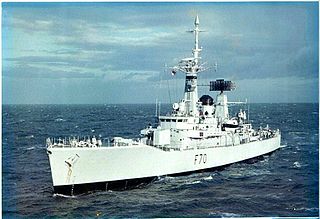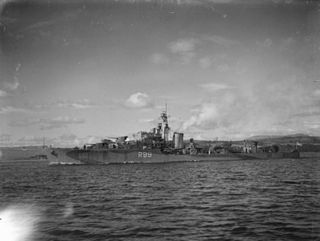
The Leander-class, or Type 12I (Improved) frigates, comprising twenty-six vessels, was among the most numerous and long-lived classes of frigate in the Royal Navy's modern history. The class was built in three batches between 1959 and 1973. It had an unusually high public profile, due to the popular BBC television drama series Warship. The Leander silhouette became synonymous with the Royal Navy through the 1960s until the 1980s.

HMS Andromeda was a Leander-class frigate of the Royal Navy. She was built at HM Dockyard Portsmouth. She was launched on 24 May 1967 and commissioned into the Royal Navy on 2 December 1968. She took part in the Falklands War. She was sold to India in 1995, for use as a training ship, being renamed INS Krishna. She was finally decommissioned in May 2012.
HMS Minerva (F45) was a Leander-class frigate of the Royal Navy. The ship commissioned in 1966 and took part in the Beira Patrol and Second Cod War during the 1970s and the Falklands War in 1982. Charles, Prince of Wales served aboard the ship in the 1970s. Between these major engagements, the frigate patrolled British territorial waters and took part in NATO and British military exercises. Minerva was decommissioned in 1992 and sold for scrap.

HMS Dido was a Royal Navy (RN) Leander-class frigate. Entering service in 1961, Dido was involved in the Indonesia–Malaysia confrontation, served with NATO's Standing Naval Force Atlantic on several occasions, and was one of the frigates used for the filming of the drama series Warship.

HMS Leander (F109) was the nameship of the Leander-class frigate of the Royal Navy (RN). She was originally intended to be part of the Rothesay class and would have been known as Weymouth. Leander was, like the rest of the class, named after a figure of the classical Greek mythology. She was built by the Harland & Wolff shipyard in Belfast, Northern Ireland and was launched on 28 June 1961. She was commissioned on 27 March 1963.

HMS Cleopatra (F28) was a Leander-class frigate of the Royal Navy (RN). Cleopatra was built at HMNB Devonport. She was launched on 21 March 1964, commissioned on 1 March 1966 and decommissioned on 31 January 1992.

HMS Naiad (F39) was a Leander-class frigate of the Royal Navy (RN). Like the rest of the class, Naiad was named after a figure or figures of mythology, in this case the Naiads of Greek mythology. Naiad was built by Yarrow Shipbuilders of Scotstoun. She was launched on 4 November 1963 and commissioned on 15 March 1965.

HMS Apollo was a batch 3B broadbeam Leander-class frigate of the Royal Navy. She was, like the rest of the class, named after a figure of mythology. Apollo was built by Yarrow Shipbuilders of Scotstoun. She was launched on 15 October 1970 and commissioned on 28 May 1972, making her the penultimate Leander.

HMS Ariadne was a Leander-class frigate of the Royal Navy. She was launched in 1971, was sold to Chile in 1992 and sunk as a target hulk in 2004.

HMS Yarmouth was the first modified Type 12 frigate of the Rothesay class to enter service with the Royal Navy.

The Type 41 or Leopard class were a class of anti-aircraft defence frigates built for the Royal Navy and Indian Navy in the 1950s. The Type 41, together with the Type 61 variant introduced diesel propulsion into the Royal Navy, the perceived benefits being long range, low fuel use, reduced crew, and reduced complexity.

The Type 61 Salisbury class was a class of the Royal Navy aircraft direction (AD) frigate, built in the 1950s. The purpose of the aircraft direction ships was to provide radar picket duties at some distance from a carrier task force and offer interception guidance to aircraft operating in their area.

The Rothesay class, or Type 12M frigates were a class of frigates serving with the Royal Navy, South African Navy and the Royal New Zealand Navy.

KD Hang Tuah is a frigate formerly operated by the Royal Malaysian Navy from 1977 until 2018. She is now a museum ship. She was built in the United Kingdom, originally for the Ghana Navy, but was launched and completed as a private venture, before being purchased by the Royal Navy in 1972. She served for five years as HMS Mermaid (F76) before being purchased by Malaysia, where she replaced another ex-British frigate also called Hang Tuah. She became a training ship in 1992 and was refitted to replace obsolete weapons and machinery.

HMS Rothesay was the lead ship of the Rothesay or Type 12M class of anti-submarine frigates of the British Royal Navy. She was commissioned in 1960 and scrapped in 1988.

HMS Falmouth was a Rothesay-class, or "Improved Type 12", anti-submarine frigate built for the Royal Navy during the 1950s. She took part in the Third Cod War in 1976, ramming the Icelandic gunboat V/s Týr. Both ships suffered extensive damage.

HMS Salisbury was a Salisbury-class or Type 61 aircraft direction frigate of the British Royal Navy. Completed in the late 1950s, Salisbury served through the 1960s and 1970s, participating in the Beira Patrol, blockading against Rhodesia and the confrontation with Iceland over fishing rights that was known as the Cod Wars. Salisbury became a harbour training ship in 1980, before being sunk as a target in 1985.

HMS Jaguar (F37), was a Leopard-class Type 41 anti-aircraft frigate of the British Royal Navy, named after the jaguar. Jaguar was the last frigate built by William Denny and Brothers for the Royal Navy. Unlike the rest of her class, she was fitted with controllable pitch propellers.

HMS Undaunted was a U-class destroyer of the British Royal Navy that saw service during World War II. She was later converted into a Type 15 fast anti-submarine frigate, with the new pennant number F53.

HMS Urchin was a U-class destroyer of the British Royal Navy that saw service during the Second World War.


















